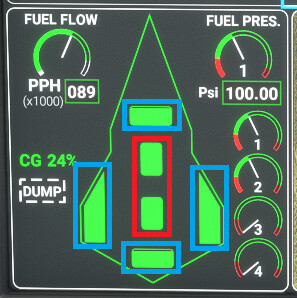Hi team,
I had a slow day at work, first one in months…and I’m isolating at home with COVID (but feeling okay) so I thought I’d take the Darkstar through its paces a bit so I can use it in future Xmas treks if I’m threatening to run out of time.
I know it’s not a real aircraft and they’ve made the thing pretty darn forgiving…but it’s still kind of nice to know what it can do…and honestly, it is quite fun.
The thing I’m most interested in, is the range. The game states the range as 2,500 NM and endurance one hour:
Let’s have a look at that in a bit more detail. The Darkstar has four fuel tanks for the turbine engines and two fuel tanks for the scramjets.
The four conventional tanks total 17,849 lbs of fuel.
The scramjet tanks total 21,815 lbs of fuel.
As far as I can tell, the only fuel gauge in the Darkstar is the visualization of the aircraft with the tanks showing in green. The middle tanks (marked red below) are the scramjet tanks and the outer tanks (marked blue) are the conventional jet fuel tanks.
It appears that the fuel flow gauge shows turbine FF when the scramjets are off and scramjet FF when the scramjets are on and the turbines off.

The turbine fuel flow varies quite a bit, but full afterburner at low altitude tops out somewhere around 120-150 x 1000 PPH, less on lower speeds (perhaps 80-100 PPH). So somewhere between 7 and 12 minutes of full burner at low altitude before flameout. Not that we would do that, but it’s good to know.
A more useful statistic is that 90% RPM maintains a benign 400 kts at the kind of altitudes you may find yourself if looking for an airport after a speed run, and results in a 14 x 1000 PPH fuel flow, i.e. 233 lbs/min.
This was a useful thing to know - because I found that a typical ascent to the scramjet transition takes a bit less than 50% of turbine fuel, so the other 9,000 lbs actually gives over 30 minutes of powered flight at the other end.
I decided to try an Auckland - Darwin speed run to see if my theory held true.
I chose an IFR MSFS flight plan but deleted everything except the approach waypoints so the computer would show me a useful distance through the flight. The shaded area shows the approximate location of my projected crash site. 2777 NM distance to cover.
Acknowledge last transmission? So you can moan about how I need to descent back to FL450 or whatever? No thanks…farewell!
According to the FF gauge, the scramjet cruise FF is around 45-68 x 1000 PPH, which results in around 20-30 minutes of scramjet time. Depending on the speed, the Darkstar might be covering around 90-95 NM / minute at this stage of the flight, so somewhere between 1,800-2,800 NM range (that’s a bit of a large window, sorry, but I don’t have more granular info right now! I did get my highest speed towards the end of the cruise when the tanks were almost empty - but haven’t tested more). I topped out at M9.8.
I was running some rough numbers halfway through and estimated that I’d run out of scramjet fuel some 400NM before the approach waypoint, which is what happened:
Still going (positive FF), 414NM to waypoint:
Out of juice (no FF, rapid deceleration), 378 NM to waypoint:
I figured I’d gently coast down and see how things go. I coasted down to 80,000 ft, at which point the turbine engines automatically spooled back up to idle. I brought them back to full RPM but no afterburner, which maintained around M3.5 with 15 x 1000 PPH. Not bad at all: at 250 lbs / min I had half an hour of powered flight left and just 189 NM to go. I probably should have started descending earlier, but altitude was money in the bank at this point.
The descent at idle took very little fuel, so at the first approach waypoint I still had my wing tanks full.
On final.
Coming in to land at 160 kts. A bit slow, perhaps - at 150 kts she falls off the sky, I think.
So…2777 NM flight wasn’t a problem. I think I could do a lot longer, just need to run some numbers.
































